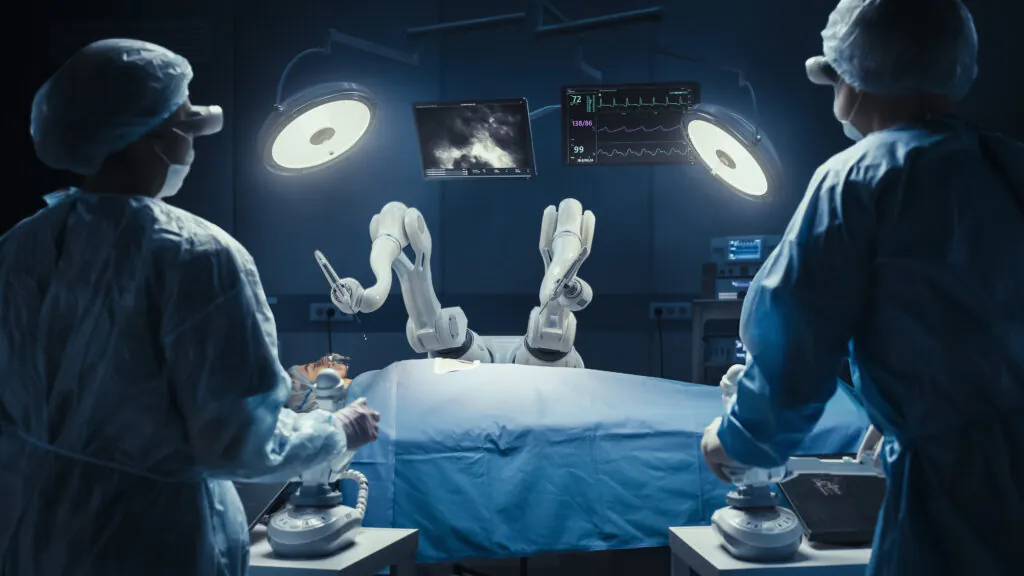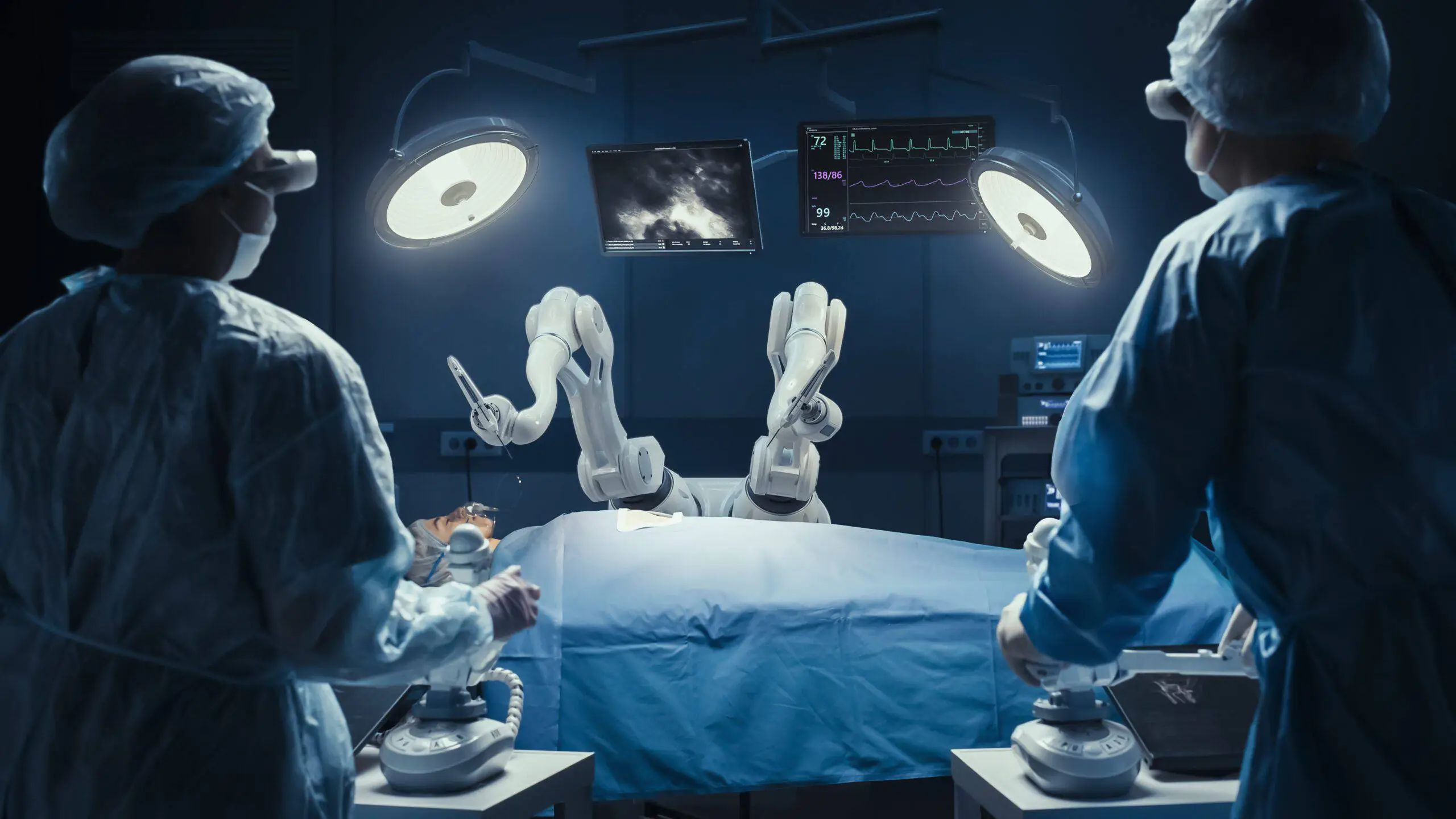Overview
Robotic surgery is redefining the future of medical procedures by pushing the boundaries of what is possible in the operating room. As technology continues to evolve, this innovative approach is poised to play an increasingly central role in medicine. Advances in artificial intelligence (AI) and machine learning are expected to further enhance the capabilities of robotic systems, enabling more autonomous surgical procedures and improved decision-making support. Furthermore, the integration of augmented reality (AR) and virtual reality (VR) could revolutionize surgical planning and training, making operations even more precise and reducing the risk of complications. These technological advancements will likely make robotic surgery more accessible, leading to better patient outcomes and transforming the way surgeries are performed. The ongoing innovation in this field promises a future where surgeries are safer, less invasive, and more effective, ultimately benefiting patients and healthcare systems worldwide.
Top Five Robotic Surgery Companies
Robotic surgery has emerged as one of the most transformative technologies in the medical field, enabling surgeons to perform highly precise and minimally invasive procedures. The industry is led by the top five companies that have made significant contributions to the development and deployment of robotic surgical systems.
Top Five Robotic Surgery Companies
Intuitive Surgical
A pioneer in robotic surgery, Intuitive Surgical's da Vinci Surgical System is renowned for its advanced features and extensive global presence, with over 8,600 units installed worldwide.
Medtronic
Medtronic's Hugo Robotic-Assisted Surgery (RAS) System offers a cost-effective, modular alternative in robotic surgery, focusing on advanced data analytics for improved surgical outcomes.
Stryker Corporation
Stryker's Mako Robotic-Arm Assisted Surgery System specializes in orthopedic surgeries, utilizing CT-based 3D modeling for surgical planning and enhanced precision in joint replacements.
Zimmer Biomet
The ROSA Robotic System by Zimmer Biomet enhances precision in neurosurgical and orthopedic procedures, supported by advanced imaging technologies for optimal instrument positioning.
Globus Medical
Globus Medical's ExcelsiusGPS Robotic Navigation Platform provides robotic guidance for spinal surgeries, facilitating minimally invasive procedures and achieving precision in implant placement.
1. Intuitive Surgical
- Flagship product: da Vinci Surgical System
- Market position: Intuitive Surgical is widely regarded as the pioneer and leader in robotic surgery. Founded in 1995, the company introduced the da Vinci Surgical System, which has become synonymous with robotic-assisted surgery. Intuitive holds a dominant market share, with over 7,000 da Vinci systems installed worldwide.
- Technological innovations: The da Vinci system is known for its high-definition 3D visualization, EndoWrist instruments that mimic the dexterity of the human hand, and advanced ergonomic design that enhances surgeon comfort and precision. Intuitive continues to innovate with the introduction of AI-powered features like integrated machine learning to assist with surgical planning and real-time decision support. The company is also expanding into new surgical areas, including single-port surgeries and autonomous robotic procedures.
- Clinical applications: The da Vinci system is used in a wide range of surgeries, including urological procedures like prostatectomies, gynecological surgeries, cardiothoracic surgeries, and general surgeries such as hernia repairs and colorectal surgeries. The system’s versatility and extensive clinical data supporting its efficacy have made it a trusted tool in many operating rooms.
- Recent information and future expansion: In Q4 2023, Intuitive Surgical reported a 21% increase in da Vinci procedures and a 14% growth in its installed base of systems, reaching 8,606 units. The company anticipates a 13%-16% increase in procedures for 2024, driven by a rise in US general surgery procedures.
2. Medtronic
- Flagship product: Hugo Robotic-Assisted Surgery (RAS) System
- Market position: Medtronic, a global leader in medical technology, entered the robotic surgery market to provide a more cost-effective and modular alternative to existing systems. The Hugo RAS system is designed to be adaptable and accessible, targeting a broader range of hospitals and healthcare providers, especially in emerging markets.
- Technological innovations: Hugo’s modular design allows hospitals to customize the system according to their needs, offering flexibility in surgical applications and cost management. Medtronic integrates advanced data analytics and connectivity features into Hugo, enabling remote monitoring, performance tracking, and AI-driven insights for continuous improvement in surgical outcomes.
- Clinical applications: The Hugo system is designed for a variety of procedures, including general surgery, urology, gynecology, and thoracic surgery. Medtronic is leveraging its extensive network and partnerships in the medical field to accelerate the adoption of Hugo in hospitals worldwide.
- Recent information and future expansion: Medtronic’s robotic surgery division is expected to grow significantly, with a focus on integrating AI and advanced technologies into its systems. The company is actively involved in developing next-generation surgical solutions.
3. Stryker Corporation
- Flagship product: Mako Robotic-Arm Assisted Surgery System
- Market position: Stryker is a leader in orthopedic robotic surgery, with its Mako system being widely used for joint replacement surgeries. Stryker’s expertise in orthopedic implants complements the Mako system, providing a comprehensive and integrated solution for knee and hip surgeries.
- Technological innovations: The Mako system uses CT-based 3D modeling to create a personalized surgical plan for each patient. During the procedure, the robotic arm assists the surgeon in executing the plan with high precision, ensuring optimal placement of implants and alignment of joints. This technology reduces variability in surgical outcomes and enhances recovery times for patients.
- Clinical applications: Mako is primarily used in orthopedic surgeries, particularly for partial and total knee replacements and hip replacements. The system’s precision in bone preparation and implant positioning has led to improved patient outcomes, including reduced pain and faster rehabilitation.
- Recent information and future expansion: The company reported a 10.5% organic revenue growth for FY23 and expects to maintain a 10% growth rate into FY24. In February 2024, Stryker launched the myMako app, allowing surgeons to access surgical plans outside the operating room, further integrating technology into surgical practice.
4. Zimmer Biomet
- Flagship product: ROSA Robotic System
- Market position: Zimmer Biomet, a leader in musculoskeletal healthcare, has developed the ROSA Robotic System to enhance precision in both neurosurgical and orthopedic procedures. ROSA is a versatile platform that supports a range of surgeries, from brain and spine operations to knee replacements.
- Technological innovations: ROSA is equipped with advanced imaging and navigation technologies that enable precise positioning of surgical instruments and implants. For neurosurgery, ROSA provides accurate targeting for procedures such as deep brain stimulation and tumor resections. In orthopedic applications, the system assists in achieving optimal alignment and positioning of knee implants, improving surgical outcomes.
- Clinical applications: ROSA is used in both neurosurgical and orthopedic settings. In neurosurgery, it is particularly valuable for complex brain and spine surgeries, while in orthopedics, it is primarily focused on knee replacement procedures. Zimmer Biomet’s extensive portfolio of implants and surgical tools complements the ROSA system, offering a complete solution for surgeons.
- Recent information and future expansion: The company has been active in expanding its robotic offerings and is involved in various initiatives to enhance its surgical solutions. Specific recent initiatives were not detailed, but Zimmer Biomet continues to play a significant role in the orthopedic robotic surgery market.
5. Globus Medical
- Flagship product: ExcelsiusGPS Robotic Navigation Platform
- Market position: Globus Medical is a leading company in the musculoskeletal and spine surgery markets, achieving record net sales of US$616.5 million in Q4 2023 and a full-year total of US$1.568 billion. The recent merger with NuVasive is expected to further enhance its market position through integrated technologies and expanded product offerings.
- Technological innovations: ExcelsiusGPS platform provides robotic guidance and integrated navigation for precise spinal implant placement. The minimally invasive support enhances surgical precision with minimal trauma and quicker recovery. Advanced workflows streamline surgical planning and execution with real-time imaging and intuitive controls.
- Clinical applications: Spinal implants improve accuracy in implant placement for conditions like scoliosis and spinal fractures. Minimally invasive surgery facilitates smaller incisions and faster patient recovery. Complex procedures assist in complex spinal surgeries and deformity corrections with high precision.
- Recent information and future expansion: In Q4 2023, Globus Medical reported worldwide net sales of US$616.5 million, with a full-year total of US$1.568 billion. The company anticipates continued growth, particularly due to its recent merger with NuVasive. This merger is expected to yield significant synergies, further strengthening Globus Medical’s position in the spine surgery market and expanding its product offerings.
Explore the Future of Surgery with Our Expert Insights: Discover how cutting-edge robotic technologies are shaping the medical landscape. Schedule a consultation with our specialists today to stay ahead in the evolving healthcare industry…
Other Major Robotic Surgery Companies

Beyond these five leading companies, other prominent firms in the field of robotic surgery showcase a diverse array of approaches and innovations. Each contributes to the advancement of minimally invasive surgical techniques with its distinctive technologies and solutions.
| Company | Description of the Robotic Surgery System |
| Johnson & Johnson | A leading player in the robotic surgery field, the company offers the STERIS robotic system, which integrates advanced robotics with surgical instruments to enhance precision and control during minimally invasive procedures. Their platform aims to streamline workflows and improve surgical outcomes. |
| Vicarious Surgical | Vicarious Surgical focuses on developing the Vicarious Surgical Robot, a novel robotic system designed to replicate the dexterity and precision of human hands. Their technology emphasizes a more intuitive and less invasive approach, leveraging a unique 3D visualization system to improve surgical precision. |
| Titan Medical | Titan Medical is known for its SPORT Surgical System, a platform that combines robotic technology with a compact, flexible design. The system is designed to facilitate minimally invasive surgeries with high precision and enhanced visualization. |
| Siemens Healthineers | Siemens Healthineers provides advanced robotic solutions through its Versius robotic system. The system integrates robotics with cutting-edge imaging technology, offering enhanced flexibility and precision for a wide range of surgical procedures. |
| Asensus Surgical | Asensus Surgical offers the Senhance Surgical System, which utilizes augmented reality and haptic feedback to enhance the surgeon’s capabilities. The system features robotic arms with advanced instrumentation and is designed to improve surgical accuracy and control. |
| CMR Surgical | CMR Surgical’s Versius system stands out for its modular and scalable design, aiming to make robotic surgery more accessible. The platform is noted for its flexibility, allowing for easy integration into existing surgical workflows. |
| Moon Surgical | Moon Surgical is developing the Star System, a robotic platform designed to assist surgeons with minimally invasive procedures. The system focuses on enhancing dexterity and control, providing a more intuitive interface for surgical precision. |
| EndoQuest Robotics | EndoQuest Robotics is advancing the field with its EndoQuest System, which incorporates robotic technology to facilitate complex laparoscopic surgeries. The system emphasizes precision, flexibility, and ease of use to support various surgical applications. |
Take the first step toward transforming your surgical outcomes. Connect with our experts to learn how leading-edge robotic solutions can enhance precision, efficiency, and patient care…
Future Trends in Robotic Surgery
The future of robotic surgery is poised for transformative advancements, driven by several emerging trends:
Miniaturization and Micro-Robotics
Robotic systems are becoming smaller and more efficient with the advent of micro-robots (microbots) capable of operating inside the body. These microbots are designed for applications such as surgery, and targeted therapies, with ongoing efforts to enhance their intelligence and adaptability to the body’s dynamic conditions.
Integration of Artificial Intelligence (AI) and Machine Learning
AI will enhance robotic systems with predictive capabilities, helping to foresee surgical challenges and tailor surgical plans based on patient-specific data. Advanced machine learning algorithms will provide real-time feedback and assist in decision-making during procedures, improving precision and surgical outcomes.
Haptic Feedback and Sensory Perception
Advances in haptic technology will enable surgeons to experience a sense of touch and depth during robotic procedures, improving the accuracy and feel of operations, closely mimicking traditional surgical techniques. Robotic surgery is expanding into diverse medical fields such as orthopedics, and general surgery.
Remote Surgery and Telepresence
Integration of telepresence technologies will enable surgeons to perform procedures from remote locations using robotic systems. This capability will bridge geographic gaps and enhance access to specialized care in underserved areas.
Augmented Reality (AR) and Virtual Reality (VR) Integration
AR and VR will revolutionize surgical planning and simulation by creating detailed 3D models of patient anatomy, allowing surgeons to rehearse and refine procedures. AR will provide real-time overlays of critical information during surgery, improving precision and situational awareness.
Expansion of Minimally Invasive Techniques
Advances in surgical robotics will facilitate single-port surgeries, significantly reducing scarring and recovery times. Development of micro-robots and nano-robots will enable even less invasive procedures with access to previously difficult-to-reach areas, allowing for more precise interventions.
Broader Adoption and Accessibility
As robotic technology becomes more affordable, its adoption will increase across various healthcare facilities, including those in emerging markets. Expanded training programs will support the widespread adoption of robotic systems, enabling more surgeons to utilize these advanced tools.
Personalized and Precision Medicine
Future robotic systems will offer personalized surgical solutions by integrating genetic and clinical data to optimize procedures. Advances in personalized medicine will allow for more tailored surgical planning, enhancing outcomes based on individual patient factors.
These trends reflect a dynamic evolution in robotic surgery, promising enhanced precision, reduced invasiveness, and broader applicability, ultimately transforming the field and improving patient care.
Conclusion
The top five companies in robotic surgery namely Intuitive Surgical, Medtronic, Stryker Corporation, Zimmer Biomet, and Globus Medical are at the forefront of a rapidly evolving industry that is transforming the way surgeries are performed. Each company brings unique strengths and innovations to the market, driving the adoption of robotic systems across various medical specialties. As these companies continue to develop and refine their technologies, the future of surgery is set to become even more precise, minimally invasive, and patient-centered, ultimately improving outcomes and reducing healthcare costs worldwide.



